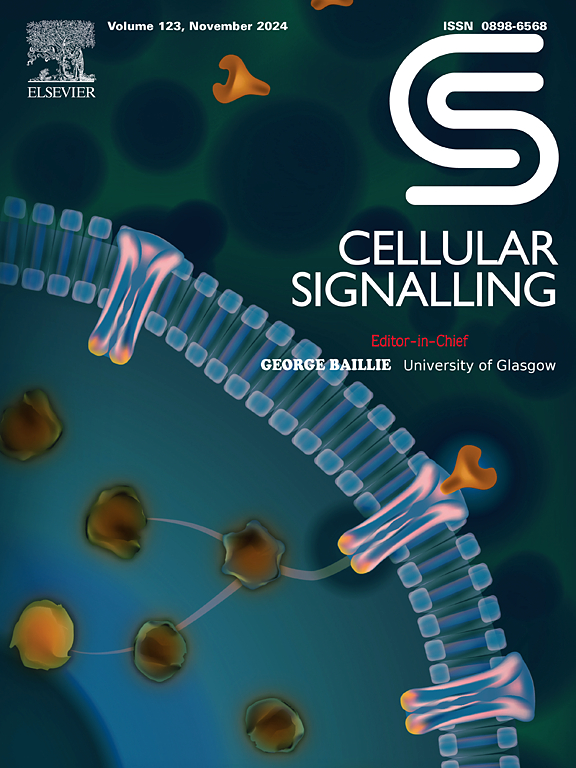tRF-3019A/STAU1/BECN1轴促进结肠癌自噬和恶性进展
IF 4.4
2区 生物学
Q2 CELL BIOLOGY
引用次数: 0
摘要
肿瘤的发生、进展和转移可能与新型非编码RNA trna衍生片段(trf)的异常水平有关。trf - 3019a在结肠癌恶性发展中的作用和可能机制尚不明确。方法采用qRT-PCR检测结肠癌细胞株和临床标本中trf - 3019a的转录水平。利用锁定核酸(LNA)-tRF-3019 A或小分子模拟物控制细胞中tRF-3019 A的水平,并采用CCK8检测评估细胞的增殖能力。采用Transwell实验评估细胞迁移率和侵袭性。荧光显微镜观察GFP-LC3B的形成,western blot分析自噬相关蛋白的表达。通过RNA拉下实验和RNA免疫沉淀分析证实了STAU1与BECN1以及trf - 3019a与STAU1之间的相互作用。采用qRT-PCR和western blot检测STAU1和BECN1的mRNA和蛋白表达。建立小鼠异种移植瘤模型,观察肿瘤的生长情况。采用qRT-PCR检测肿瘤组织中trf - 3019a、STAU1、BECN1的转录水平,采用WB检测肿瘤组织中STAU1、BECN1、自噬相关蛋白、上皮间质转化(epithelial-mesenchymal transition, EMT)相关蛋白的表达。结果在结肠癌组织和细胞中,trf - 3019a过表达,通过引发细胞自噬,促进细胞分裂、迁移和侵袭。从机制角度看,trf - 3019a通过BECN1 mRNA与STAU1蛋白竞争性结合,从而增强自噬相关蛋白BECN1的稳定表达。在STAU1敲低的异种移植肿瘤小鼠模型中,阻断trf - 3019a可显著降低肿瘤发展速度,降低emt相关蛋白和自噬的表达,抑制自噬。结论trf - 3019a通过BECN1 mRNA与STAU1蛋白竞争性结合,激活肿瘤细胞自噬,促进结肠癌恶性进展。本文章由计算机程序翻译,如有差异,请以英文原文为准。
tRF-3019A/STAU1/BECN1 axis promotes autophagy and malignant progression of colon cancer
Background
Tumor incidence, progression, and metastasis may be linked to the aberrant levels of novel non-coding RNA tRNA-derived fragments (tRFs). Uncertainty surrounds the role and possible mechanism of tRF-3019 A in causing colon cancer to proceed malignantly.
Methods
By using qRT-PCR, transcription levels of tRF-3019 A were found in colon cancer cell lines and clinical samples. Locked nucleic acid (LNA)-tRF-3019 A or small molecule mimic was utilized to control the levels of tRF-3019 A in cells, and the CCK8 test was employed to assess the cells' capacity for proliferation. The rate of cell migration and invasiveness were assessed using the Transwell Assay. GFP-LC3B formation was seen using fluorescence microscopy, and autophagy-related protein expression was found using western blot analysis. The interactions between STAU1 and BECN1 and between tRF-3019 A and STAU1 were confirmed by RNA pull-down assay and RNA immunoprecipitation analyses. The mRNA and protein expression of STAU1 and BECN1 were found using qRT-PCR and western blot (WB). A xenograft tumor model was constructed to observe the growth of mouse tumors. qRT-PCR was used to detect the transcription levels of tRF-3019 A, STAU1, and BECN1, while WB was used to detect the expression of STAU1, BECN1, autophagy-related proteins, and epithelial-mesenchymal transition (EMT) -related proteins in tumor tissues.
Results
In colon cancer tissues and cells, tRF-3019 A was overexpressed, and by triggering autophagy, it may encourage cell division, migration, and invasion. From a mechanistic perspective, tRF-3019 A competitively bound to the STAU1 protein with BECN1 mRNA, thereby enhancing the stable expression of the autophagy-related protein BECN1. In the model of xenograft tumor mice with knockdown of STAU1, blocking tRF-3019 A led to a substantial decrease in the pace of tumor development, a reduction in the expression of EMT-related proteins and autophagy, and an inhibition of autophagy.
Conclusion
tRF-3019A activated tumor cell autophagy and promoted the malignant progression of colon cancer by competitively binding to the STAU1 protein with BECN1 mRNA.
求助全文
通过发布文献求助,成功后即可免费获取论文全文。
去求助
来源期刊

Cellular signalling
生物-细胞生物学
CiteScore
8.40
自引率
0.00%
发文量
250
审稿时长
27 days
期刊介绍:
Cellular Signalling publishes original research describing fundamental and clinical findings on the mechanisms, actions and structural components of cellular signalling systems in vitro and in vivo.
Cellular Signalling aims at full length research papers defining signalling systems ranging from microorganisms to cells, tissues and higher organisms.
 求助内容:
求助内容: 应助结果提醒方式:
应助结果提醒方式:


